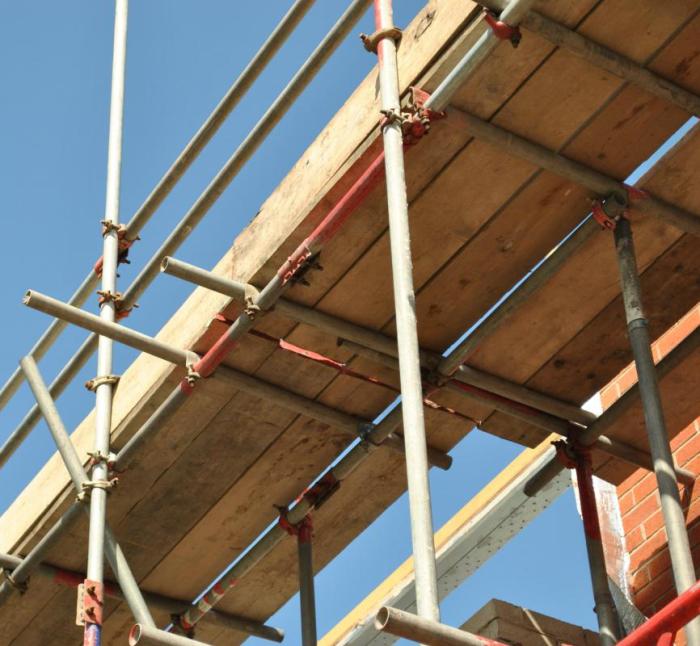How to make scaffolds – Embark on a journey into the world of scaffolding construction with our comprehensive guide. From understanding materials and design principles to erecting and dismantling scaffolds safely, we’ll equip you with the knowledge and techniques to tackle any scaffolding project with confidence.
Delve into the diverse materials used for scaffolding, including wood, metal, and plastic. Discover the various types of scaffolding systems, such as tube and clamp, system, and suspended, and learn when each is most appropriate.
Scaffolding Materials and Types

Scaffolding is a temporary structure that provides support for workers and materials at elevated heights. It is essential for construction, maintenance, and other industries. There are various materials and types of scaffolding, each with its own advantages and applications.
Scaffolding Materials
- Wood:Traditional and cost-effective, but requires regular maintenance and is susceptible to rot and fire.
- Metal:Durable, strong, and fire-resistant, but heavier and more expensive than wood.
- Plastic:Lightweight, corrosion-resistant, and non-conductive, but less durable than metal.
Scaffolding Types
- Tube and Clamp Scaffolding:Consists of metal tubes and clamps, allowing for flexibility and adaptability to complex structures.
- System Scaffolding:Prefabricated frames that are assembled together, offering quick and easy setup.
- Suspended Scaffolding:Hung from above, providing access to areas where traditional scaffolding cannot reach.
The choice of scaffolding type depends on factors such as height, load capacity, access requirements, and the specific task.
Scaffolding Design and Planning: How To Make Scaffolds
Proper design and planning are crucial for the safety and efficiency of scaffolding. Key factors to consider include:
- Height:Determines the required strength and stability of the scaffold.
- Load Capacity:Indicates the maximum weight the scaffold can support, including workers, materials, and equipment.
- Access:Ensuring safe and convenient access to work areas.
Engineering calculations and inspections are essential to ensure the scaffold meets safety standards and regulations.
Key Design Considerations for Different Scaffolding Types
| Scaffolding Type | Key Design Considerations |
|---|---|
| Tube and Clamp | Tube diameter, clamp spacing, bracing |
| System | Frame size, load capacity, connection details |
| Suspended | Suspension points, anchorage, counterweights |
Scaffolding Erection and Dismantling

Scaffolding erection and dismantling require careful planning and adherence to safety procedures.
Scaffolding Erection
- Base setup: Ensure a stable and level base.
- Platform assembly: Install platforms at appropriate heights.
- Bracing: Add braces to ensure rigidity and stability.
Safety Precautions
- Use fall protection equipment.
- Follow proper assembly instructions.
- Inspect the scaffold before and after use.
Scaffold Inspection and Maintenance, How to make scaffolds
- Regular visual inspections for damage or defects.
- Periodic load tests to verify load capacity.
- Repairs or replacements as needed.
Scaffolding Applications and Uses

Scaffolding is used in various industries and applications, including:
- Construction:Building facades, interior fit-outs, and high-rise structures.
- Painting and Maintenance:Reaching high areas for painting, repairs, and cleaning.
- Shipbuilding and Offshore Construction:Providing access to complex structures and equipment.
Advantages of using scaffolding include:
- Safety:Provides a safe and stable platform for workers.
- Access:Allows access to elevated areas and complex structures.
- Productivity:Improves efficiency by providing a convenient work platform.
Limitations include:
- Cost:Can be expensive to erect and dismantle.
- Space:Requires significant space, which may be limited in confined areas.
Scaffolding Safety and Regulations

Scaffolding poses several safety hazards, including:
- Falls:From heights or through openings.
- Collapse:Due to improper assembly, overloading, or environmental factors.
- Electrocution:Contact with overhead power lines.
Regulations and standards govern scaffolding use and inspection, including:
- OSHA (United States):Standards for scaffolding design, erection, and use.
- EN 12811 (Europe):European standard for scaffolding safety.
Tips for preventing scaffolding accidents:
- Train workers on proper scaffolding use and safety.
- Use fall protection equipment.
- Inspect scaffolding regularly.
- Follow all safety regulations and guidelines.
FAQ
What are the most common types of scaffolding?
Tube and clamp, system, and suspended scaffolding are the most widely used types.
How do I ensure the safety of my scaffolding?
Follow regulations, inspect regularly, and train workers on proper erection and dismantling techniques.
